The global bioelectrochemical systems for wastewater treatment market is projected to grow from USD 1.5 billion in 2025 to approximately USD 4.5 billion by 2035, recording an absolute increase of USD 3.01 billion over the forecast period. This translates into a total growth of 207.6%, with the market forecast to expand at a compound annual growth rate (CAGR) of 11.9% between 2025 and 2035. The overall market size is expected to grow by nearly 3.08X during the same period, supported by increasing environmental regulations, rising demand for sustainable wastewater treatment solutions, and growing focus on energy recovery from wastewater.
Between 2025 and 2030, the bioelectrochemical systems for wastewater treatment market is projected to expand from USD 1.5 billion to USD 2.63 billion, resulting in a value increase of USD 1.18 billion, which represents 39.2% of the total forecast growth for the decade. This phase of growth will be shaped by rising environmental awareness about sustainable wastewater treatment, increasing demand for energy-efficient water treatment technologies, and growing penetration of advanced bioelectrochemical systems in emerging markets. Water treatment companies are expanding their bioelectrochemical product portfolios to address the growing demand for multifunctional wastewater treatment solutions.
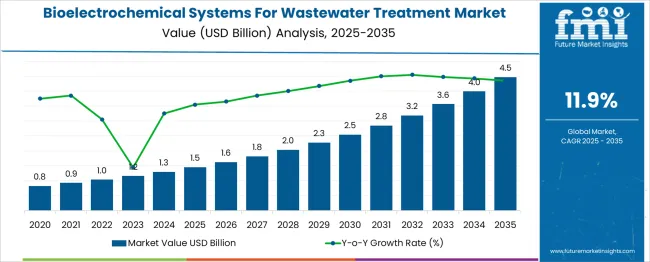
| Metric | Value |
| Estimated Value in (2025E) | USD 1.5 billion |
| Forecast Value in (2035F) | USD 4.5 billion |
| Forecast CAGR (2025 to 2035) | 11.9% |
From 2030 to 2035, the market is forecast to grow from USD 2.63 billion to USD 4.5 billion, adding another USD 1.83 billion, which constitutes 60.8% of the overall ten-year expansion. This period is expected to be characterized by expansion of industrial applications, integration of advanced monitoring systems in bioelectrochemical systems, and development of hybrid treatment technologies. The growing adoption of circular economy principles and resource recovery from wastewater will drive demand for advanced bioelectrochemical systems with enhanced efficiency and energy recovery capabilities.
Between 2020 and 2025, the bioelectrochemical systems for wastewater treatment market experienced steady expansion, driven by increasing environmental regulations and growing awareness of sustainable water treatment solutions. The market developed as water treatment companies recognized the need for energy-efficient technologies to address growing wastewater treatment challenges. Government initiatives and regulatory support began emphasizing the importance of bioelectrochemical systems in achieving sustainable wastewater management and resource recovery goals.
Market expansion is being supported by the increasing global focus on sustainable wastewater treatment technologies and the corresponding demand for energy-efficient water treatment solutions. Modern water treatment facilities are increasingly focused on technologies that can simultaneously treat wastewater and recover energy, making bioelectrochemical systems an attractive option. The proven efficacy of these systems in reducing organic pollutants while generating electricity makes them a preferred technology in sustainable water treatment applications.
The growing emphasis on circular economy principles and resource recovery is driving demand for bioelectrochemical systems that can extract value from waste streams. Water treatment facility operators prefer multifunctional systems that combine wastewater treatment with energy generation and resource recovery capabilities. The rising influence of environmental regulations and sustainability initiatives is also contributing to increased technology adoption across different industrial sectors and municipal applications.
The market is segmented by type, application, and region. By type, the market is divided into microbial fuel cells, microbial electrolysis cells, and others. Based on application, the market is categorized into industrial wastewater, municipal wastewater, agriculture wastewater, and others. Regionally, the market is divided into North America, Europe, East Asia, South Asia & Pacific, Latin America, and Middle East & Africa.
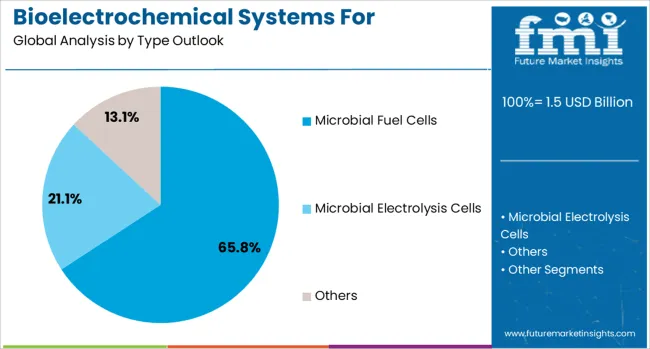
The microbial fuel cells type is projected to account for 65.8% of the bioelectrochemical systems for wastewater treatment market in 2025, reaffirming its position as the category's dominant technology. Industrial facilities and municipal treatment plants increasingly understand the potential of microbial fuel cells to simultaneously treat wastewater and generate electricity. These systems' well-documented capability to convert organic matter directly into electrical energy addresses both environmental and energy concerns of modern treatment facilities.
This technology forms the foundation of most commercial deployments, as it represents the most mature and commercially viable form of bioelectrochemical wastewater treatment. Research validation and pilot project success continue to strengthen confidence in microbial fuel cell installations. With industrial facilities seeking to reduce both treatment costs and energy consumption, microbial fuel cells align with both operational efficiency and sustainability objectives. Their broad applicability across different waste streams ensures sustained dominance, making them the central growth driver of bioelectrochemical systems demand.
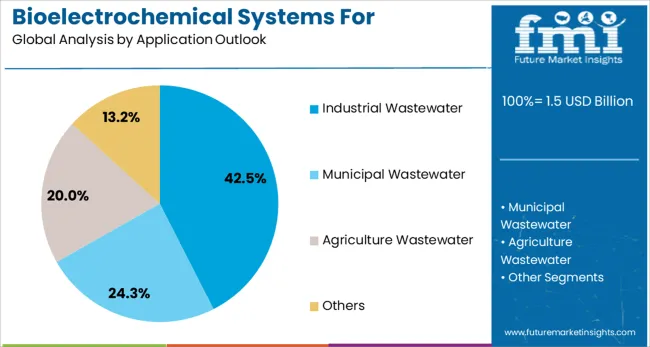
Industrial wastewater applications are projected to represent 42.5% of bioelectrochemical systems demand in 2025, underscoring their role as the primary market for advanced wastewater treatment technologies. Industrial facilities gravitate toward these systems for their ability to handle high-strength wastewater while recovering energy, maximizing both treatment efficiency and cost effectiveness. Positioned as advanced, sustainable treatment solutions, bioelectrochemical systems offer both regulatory compliance benefits and operational cost reduction through energy recovery.
The segment is supported by the increasing stringency of industrial discharge regulations, where bioelectrochemical systems play a central role in meeting environmental standards. Additionally, industries are increasingly combining bioelectrochemical treatment with other advanced technologies like membrane bioreactors or anaerobic digestion, enhancing overall treatment performance and justifying capital investments. As environmentally conscious industries prioritize sustainable operations and resource recovery, bioelectrochemical systems for industrial wastewater will continue to dominate demand, reinforcing their critical positioning within the sustainable water treatment market.
The bioelectrochemical systems for wastewater treatment market is advancing rapidly due to increasing environmental regulations and growing demand for energy-efficient treatment technologies. However, the market faces challenges including high capital costs, technical complexity, and competition from conventional treatment methods. Innovation in system design and cost reduction strategies continue to influence technology adoption and market expansion patterns.
The growing adoption of bioelectrochemical systems in industrial applications is enabling companies to achieve both wastewater treatment and energy recovery objectives. Industrial facilities offer ideal conditions for these systems, including consistent waste streams and energy cost pressures that justify advanced technology investments. Manufacturing sectors are increasingly recognizing the dual benefits of pollution control and energy generation, particularly in energy-intensive industries.
Modern bioelectrochemical system manufacturers are incorporating advanced monitoring systems, automated controls, and data analytics to enhance system performance and reliability. These technologies improve treatment efficiency while reducing operational complexity and maintenance requirements. Advanced control systems also enable integration with existing treatment infrastructure and provide better user experience through remote monitoring and predictive maintenance capabilities.
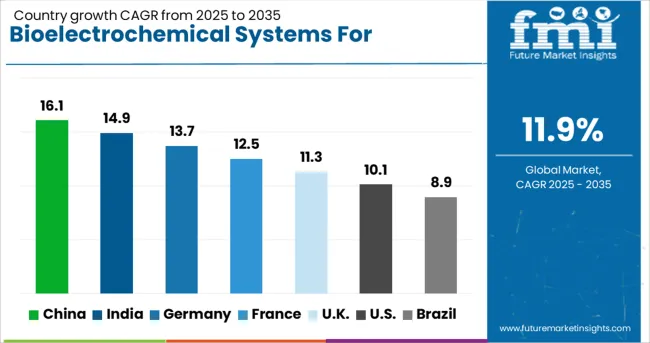
| Country | CAGR (2025-2035) |
| China | 16.1% |
| India | 14.9% |
| Germany | 13.7% |
| France | 12.5% |
| UK | 11.3% |
| USA | 10.1% |
| Brazil | 8.9% |
The bioelectrochemical systems for wastewater treatment market is experiencing robust growth globally, with China leading at a 16.1% CAGR through 2035, driven by rapid industrialization, increasing environmental regulations, and growing adoption of advanced wastewater treatment technologies. India follows closely at 14.9%, supported by expanding manufacturing sector, government initiatives for sustainable water treatment, and increasing focus on energy recovery from waste. Germany shows strong growth at 13.7%, emphasizing engineering excellence and environmental technology innovation. France records 12.5%, focusing on sustainable water management and circular economy practices. The UK shows 11.3% growth, prioritizing sustainable infrastructure and advanced treatment technologies.
The report covers an in-depth analysis of 40+ countries; six top-performing countries are highlighted below.
Revenue from bioelectrochemical systems for wastewater treatment in China is projected to exhibit strong growth with a CAGR of 16.1% through 2035, driven by rapid industrial development and increasingly stringent environmental regulations. The country's expanding manufacturing sector and growing environmental consciousness are creating significant demand for advanced wastewater treatment technologies. Major international and domestic technology providers are establishing comprehensive service networks to serve the growing population of industrial facilities requiring sustainable treatment solutions across tier-1 and tier-2 cities.
Revenue from bioelectrochemical systems for wastewater treatment in India is expanding at a CAGR of 14.9%, supported by rapid industrialization, growing environmental awareness, and increasing government focus on sustainable water treatment. The country's expanding manufacturing sector and rising environmental compliance requirements are driving demand for advanced bioelectrochemical treatment solutions. International technology providers and domestic manufacturers are establishing distribution channels to serve the growing demand for efficient industrial wastewater treatment systems.
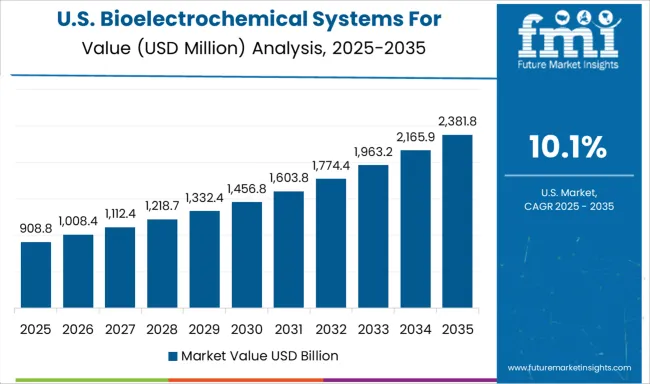
Demand for bioelectrochemical systems for wastewater treatment in the USA is projected to grow at a CAGR of 10.1%, supported by advanced environmental regulations and industry preference for sustainable treatment technologies. American industrial facilities are increasingly focused on technology efficiency, energy recovery, and regulatory compliance. The market is characterized by strong demand for proven technologies that combine treatment effectiveness with operational cost reduction.

Revenue from bioelectrochemical systems for wastewater treatment in Germany is projected to grow at a CAGR of 13.7% through 2035, driven by the country's strong focus on environmental technology, engineering innovation, and stringent water quality standards. German industrial facilities consistently demand high-performance, reliable systems that deliver measurable treatment results while meeting strict regulatory requirements.
Revenue from bioelectrochemical systems for wastewater treatment in the UK is projected to grow at a CAGR of 11.3% through 2035, supported by rising industry interest in sustainable infrastructure and circular economy principles. British industrial facilities value technology reliability, environmental performance, and proven efficiency, positioning bioelectrochemical systems as a core component of advanced treatment strategies.
Revenue from bioelectrochemical systems for wastewater treatment in France is projected to grow at a CAGR of 12.5% through 2035, supported by the country's strong emphasis on sustainable water management, technology innovation, and environmental stewardship. French industrial facilities prioritize proven performance and sustainable operations, making bioelectrochemical systems a trusted choice in the advanced treatment segment.
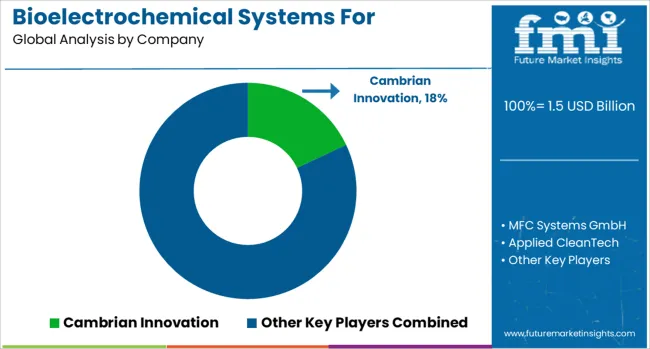
The bioelectrochemical systems for wastewater treatment market is characterized by competition among established water treatment companies, specialized technology providers, and emerging environmental technology players. Companies are investing in advanced system design, pilot project validation, comprehensive service offerings, and strategic partnerships to deliver effective, reliable, and cost-efficient bioelectrochemical treatment solutions. Technology positioning, system performance, and market expansion are central to strengthening product portfolios and market presence.
Cambrian Innovation, USA-based, leads the market with advanced bioelectrochemical treatment systems focusing on industrial applications and energy recovery. MFC Systems GmbH, Germany, provides specialized microbial fuel cell systems with emphasis on technical excellence and performance validation. Applied CleanTech, USA, delivers innovative bioelectrochemical solutions with focus on system efficiency and commercial viability. Electrochaea GmbH, Germany, focuses on advanced microbial systems that combine treatment with energy and chemical production.
METawater Co., Ltd., Japan, and Paques BV, Netherlands, operating in specialized markets, provide comprehensive bioelectrochemical treatment systems across multiple industrial applications and service offerings. Biowater Technology AS, Norway, emphasizes sustainable treatment technologies with proven performance. AquaVenture Holdings Limited offers integrated water treatment solutions with bioelectrochemical components. Organica Water and Genesis Water Technologies, Inc. provide specialized environmental solutions with focus on specific treatment challenges and sustainable technology applications.
| Items | Values |
|---|---|
| Quantitative Units (2025) | USD 1.5 billion |
| Type | Microbial Fuel Cells, Microbial Electrolysis Cells, Others |
| Application | Industrial Wastewater, Municipal Wastewater, Agriculture Wastewater, Others |
| Regions Covered | North America, Europe, East Asia, South Asia & Pacific, Latin America, Middle East & Africa |
| Countries Covered | United States, Canada, United Kingdom, Germany, France, China, Japan, South Korea, India, Brazil, Australia and 40+ countries |
| Key Companies Profiled | Cambrian Innovation, MFC Systems GmbH, Applied CleanTech, Electrochaea GmbH, METawater Co., Ltd., Paques BV, Biowater Technology AS, AquaVenture Holdings Limited, Organica Water, and Genesis Water Technologies, Inc. |
| Additional Attributes | Revenue analysis by system type and capacity level, regional demand trends, competitive landscape, buyer preferences for microbial fuel cells versus electrolysis systems, integration with conventional treatment processes, innovations in electrode materials, system optimization, and sustainable operation practices |
Type:
Application:
Region:
The global bioelectrochemical systems for wastewater treatment market is estimated to be valued at USD 1.5 billion in 2025.
The market size for the bioelectrochemical systems for wastewater treatment market is projected to reach USD 4.5 billion by 2035.
The bioelectrochemical systems for wastewater treatment market is expected to grow at a 11.9% CAGR between 2025 and 2035.
The key product types in bioelectrochemical systems for wastewater treatment market are microbial fuel cells, microbial electrolysis cells and others.
In terms of application outlook, industrial wastewater segment to command 42.5% share in the bioelectrochemical systems for wastewater treatment market in 2025.






Full Research Suite comprises of:
Market outlook & trends analysis
Interviews & case studies
Strategic recommendations
Vendor profiles & capabilities analysis
5-year forecasts
8 regions and 60+ country-level data splits
Market segment data splits
12 months of continuous data updates
DELIVERED AS:
PDF EXCEL ONLINE
Systems Administration Management Tools Market Size and Share Forecast Outlook 2025 to 2035
VRF Systems Market Growth - Trends & Forecast 2025 to 2035
Cloud Systems Management Software Market Size and Share Forecast Outlook 2025 to 2035
Hi-Fi Systems Market Size and Share Forecast Outlook 2025 to 2035
Cough systems Market
Backpack Systems Market Size and Share Forecast Outlook 2025 to 2035
Unmanned Systems Market Analysis - Size, Share, & Forecast Outlook 2025 to 2035
DC Power Systems Market Trends - Growth, Demand & Forecast 2025 to 2035
Catheter Systems Market
Reporter Systems Market
Aerostat Systems Market
Cryogenic Systems Market Size and Share Forecast Outlook 2025 to 2035
Air Brake Systems Market Growth & Demand 2025 to 2035
Metrology Systems Market
Fluid Bed Systems Market
Cognitive Systems Spending Market Report – Growth & Forecast 2016-2026
Nurse Call Systems Market Insights - Size, Share & Forecast 2025 to 2035
Excitation Systems Market Analysis – Growth, Demand & Forecast 2025 to 2035
Fire Alarm Systems Market by Solution by Application & Region Forecast till 2035
Ultrasound Systems Market Growth – Trends & Forecast 2025-2035

Thank you!
You will receive an email from our Business Development Manager. Please be sure to check your SPAM/JUNK folder too.
Chat With
MaRIA